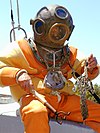Waves and shallow water
This is an old revision of this page, as edited by ClueBot NG (talk | contribs) at 21:00, 4 May 2016 (Reverting possible vandalism by 172.192.106.143 to version by Addbot. Report False Positive? Thanks, ClueBot NG. (2645666) (Bot)). The present address (URL) is a permanent link to this revision, which may differ significantly from the current revision.

When waves travel into areas of shallow water, they begin to be affected by the ocean bottom. The free orbital motion of the water is disrupted, and water particles in orbital motion no longer return to their original position. As the water becomes shallower, the swell becomes higher and steeper, ultimately assuming the familiar sharp-crested wave shape. After the wave breaks, it becomes a wave of translation and erosion of the ocean bottom intensifies.
See also
- Boussinesq equations (water waves)
- Mild-slope equation
- Shallow water equations
- Stokes drift
- Wave shoaling
- Ursell number
- Ballantine Scale
External links
This oceanography article is a stub. You can help Wikipedia by expanding it. |



